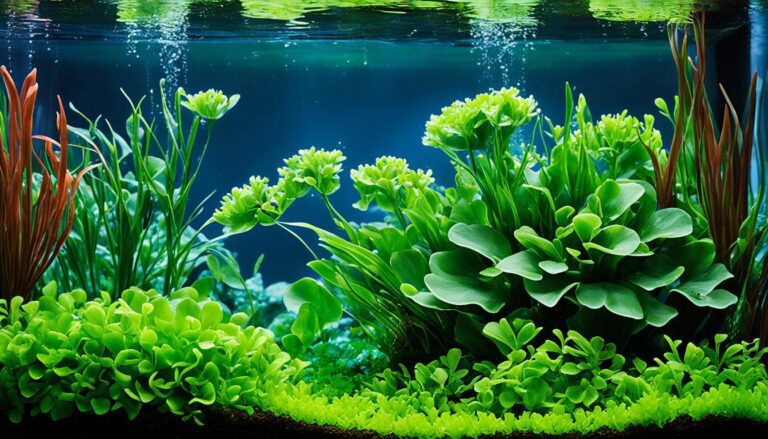I love the simplicity and beauty aquarium floating plants add to tanks. Dwarf Water Lettuce, or Pistia stratiotes, stands out with its rosette-shaped leaves. It’s not just for looks; it plays a crucial role in my tank’s health.
Caring for Dwarf Water Lettuce is easy, which is great for any fish keeper. Watching them grow from tiny plants to covering the surface is a joy. They need a tank size of 10 gallons to thrive, giving fish a lovely shelter.
To set up the perfect aquarium for floating plants, consider their needs. They like moderate light and tropical water temperatures between 72°F and 86°F. Don’t forget to prune them to keep things under control. Their roots add a touch of the wilderness to my room.
Caring for Dwarf Water Lettuce helps me appreciate the Pistia stratiotes care guide more. Following it keeps my aquatic garden healthy and vibrant. It’s a crucial part of my tank’s ecosystem.
Understanding Dwarf Water Lettuce and Its Habitat
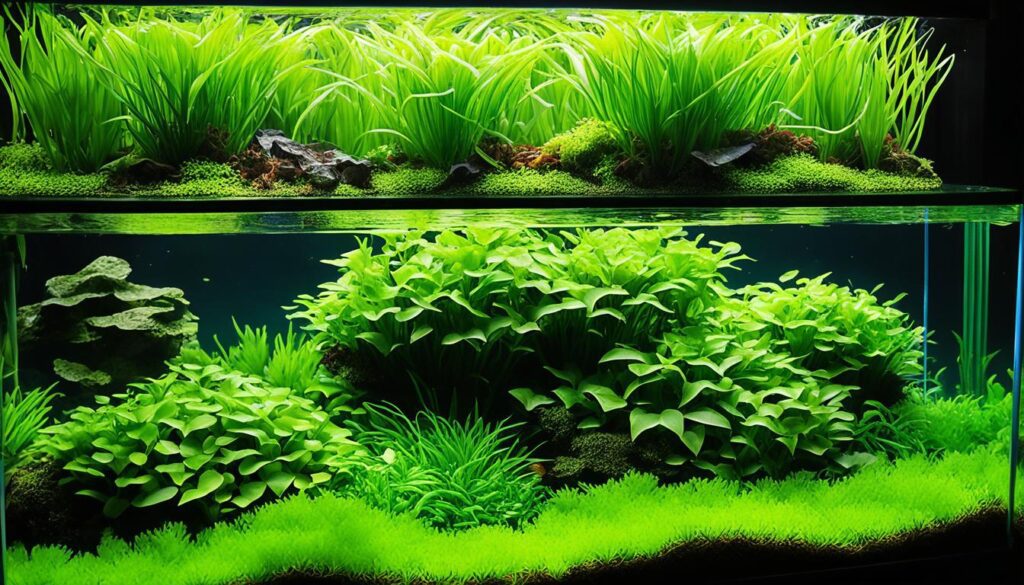
Welcome to the fascinating world of Dwarf Water Lettuce, a popular tropical floating plant that not only looks great but also brings some practical perks to your aquarium. Let’s dive into where it comes from and why it’s so special.
Origins and Natural Habitat
Dwarf Water Lettuce is well-known for floating gracefully on top of warm, still waters. It originally came from the vibrant ecosystems of the Nile River, hinting at its roots as a true Nile plant. These days, though, you can find this plant thriving in waters all over the globe.
In warmer climates, you’ll spot Dwarf Water Lettuce naturally living in big lakes and calm rivers, forming thick green blankets on the surface. Besides adding a nice touch to the scenery, it plays a key role in the ecosystem by providing shade and hiding spots for aquatic creatures. Plus, its ability to grow in all kinds of environments makes it a favorite among aquarium enthusiasts and researchers alike.
Bringing Dwarf Water Lettuce into Your Home Aquarium
Thinking of adding some Dwarf Water Lettuce to your aquarium? Awesome choice! It adapts pretty easily to tank life and keeps its vibrant green color without much fuss. Here’s what you need to know to get started:
Feature |
Requirement |
Benefits |
|---|---|---|
Temperature |
72°F to 86°F |
Optimal growth and health |
pH Level |
6.0 to 7.5 |
Supports resilience and vitality |
Water Hardness |
Soft to medium-hard |
Enhances leaf texture and color |
Lighting |
Moderate to bright (indirect) |
Promotes photosynthesis and growth |
Space |
Ample surface area |
Prevents overcrowding and promotes spread |
In your aquarium, Dwarf Water Lettuce will make it more attractive. It also helps keep the water healthy by creating shade and cutting down on algae. With proper care, your aquarium will remind you of a lush tropical waterway.
Why Dwarf Water Lettuce Belongs in Your Aquarium

Dwarf Water Lettuce, known scientifically as Pistia stratiotes, is a stunning and useful aquarium plant. This rosette-shaped plant is more than just eye-catching. It plays a big role in making the aquatic environment better. It is key for both aquarium shelter plants and water quality enhancement.
Shelter and Protection for Aquarium Inhabitants
Dwarf Water Lettuce provides shelter and protection in aquariums. Its floating leaves form a canopy on the water surface. This creates hiding spots for fish, especially the young ones, to hide from predators. It’s an essential part of the tank, mimicking the natural home of aquatic life.
Water Quality Improvement and Algae Control
Beyond offering shelter, Dwarf Water Lettuce improves water quality. It absorbs excess nutrients, like ammonia and nitrates. This prevents algae growth, acting as an aquarium algae control tool. The plant purifies water, making it healthier for all living in the tank.
Statistical Feature |
Detail |
|---|---|
Botanical Classification |
Pistia stratiotes, Family: Araceae |
Invasive Status |
Classified as an invasive species; restrictions apply in the EU |
Optimal Growth Conditions |
Temperature: 22–30°C, pH: 6.0-7.5 |
Reproduction |
Vegetatively through ‘pups’ |
Edibility |
Not palatable due to calcium oxalate |
Habitat |
Native to tropical and subtropical fresh waterways |
Adding Dwarf Water Lettuce to your aquarium boosts its look and eco-balance. It’s great for beautifying your tank or creating a healthier aquatic space. Dwarf Water Lettuce is a top choice among aquarium shelter plants. It helps make your ecosystem sustainable.
Identifying Your Dwarf Water Lettuce
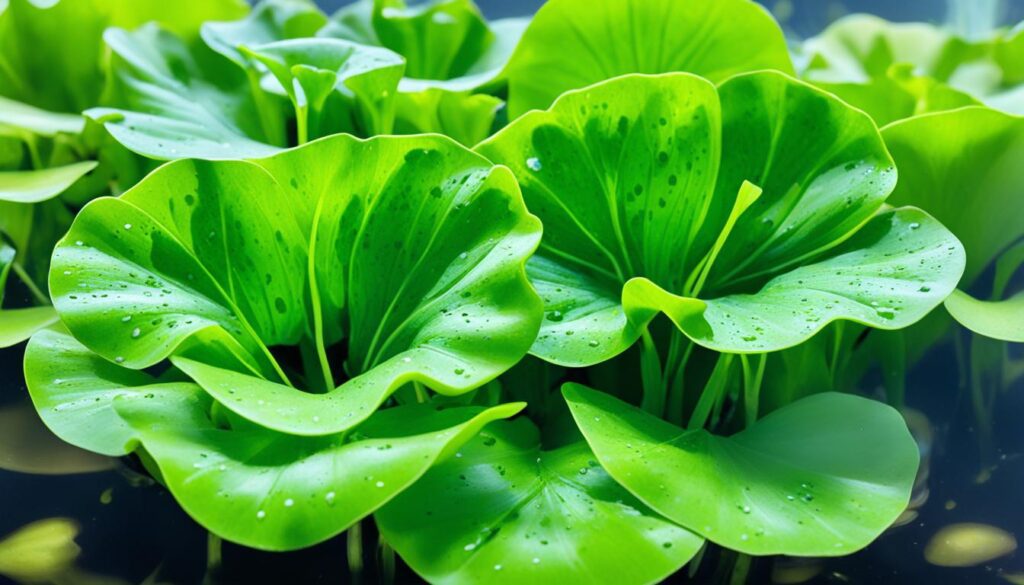
Exploring your aquarium gets exciting with Dwarf Water Lettuce around. It’s vital to know your plants well. This ensures your tank stays beautiful and balanced. Let’s dive into floating plant identification, with a focus on the Dwarf Water Lettuce appearance.
Recognizing Healthy Plants by Leaf Structure
Leaf structure is key in identifying healthy plants. Look for thick, buoyant leaves with a wavy edge on Dwarf Water Lettuce. They’re also soft due to tiny hairs. These features are unique and show the plant is healthy. They help in floating plant identification and keeping your aquarium looking good.
The Unique Aesthetics of Dwarf Water Lettuce
Dwarf Water Lettuce is both delicate and full, floating beautifully on water. Its bright green leaves spread out, enhancing aquarium plant aesthetics. Sometimes, it even blooms or bears red berries. This adds more beauty to your tank. Knowing healthy plants is about more than looks. It’s about seeing their health and contribution to your aquarium’s beauty.
| Growth Rate | Fast, can double in less than three weeks under optimal conditions |
|---|---|
| Native Habitat | Originates from South America, notorious as a resilient aquatic weed globally |
| Environmental Factors | Prefers temperatures between 72°F – 86°F, thrives in low to medium light, optimal pH of 6.5 – 7.5 |
| Legal Status | Regulated in Florida, possession without a permit is prohibited due to its invasive nature |
| Impact on Ecology | Can hinder water flow, displace native species, and decrease water quality if uncontrolled |
Dwarf Water Lettuce Care Essentials
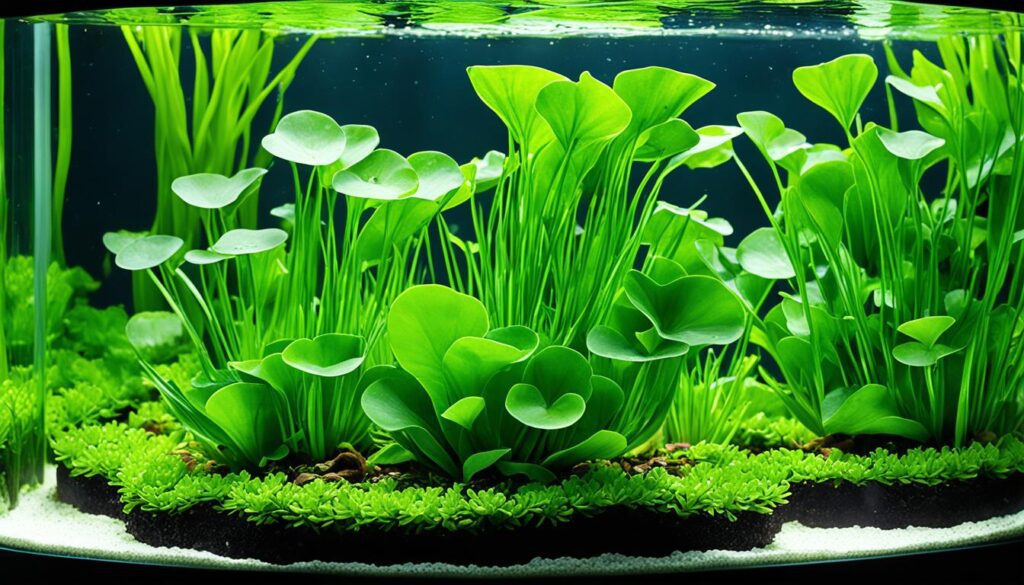
For a thriving aquarium, right on the floating plant growth conditions for Dwarf Water Lettuce is essential. Known as Pistia stratiotes, it needs specific conditions to stay healthy and look great. We’ll explore how to make these conditions perfect and keep your plants happy.
Fostering Ideal Growth Conditions
Keep the water between 68°F and 86°F for your Dwarf Water Lettuce. This plant likes a pH of 6.0 to 7.5, and the water hardness should be from 2 to 12 KH. Good light helps the plants make food and grow, but too much sun can burn the leaves.
Balance and Tank Management for Plant Health
Good aquarium plant health management means watching the plants closely. Yellow leaves can show an iron shortage, and you might need to add more. The roots help protect little fish and fight algae by keeping light away. Cutting the plants every week helps prevent too much growth.
- Check the water’s heat and acidity regularly.
- Keep the light enough but not too strong.
- Look at the leaves for clues on plant health.
- Trim weekly to manage space and health.
- Watch how the roots grow and keep them healthy.
By using these steps, you’re not just caring for Dwarf Water Lettuce. You’re making your aquarium a better place for everything living there. Healthy plants mean a balanced home for all your aquatic friends.
Condition |
Requirement |
|---|---|
Water Temperature |
68°F to 86°F |
pH Level |
6.0 to 7.5 |
Water Hardness |
2 to 12 KH |
Lighting |
Moderate to High |
Pruning Frequency |
Weekly |
Meeting these growth needs not only makes your Dwarf Water Lettuce care guide work better. It also ensures your whole aquarium thrives with life.
Choosing the Right Tank Size for Dwarf Water Lettuce

Setting up the right tank for Dwarf Water Lettuce is key. The plant needs enough room to grow without being crowded. This is why picking the right aquarium size for water lettuce matters more than you may think.
A 10-gallon tank is the smallest size you should consider. This gives the plant’s extensive roots the space they need. It helps the water lettuce grow and keeps your aquarium balanced.
The size of your tank greatly affects your Dwarf Water Lettuce. Here’s how different sizes can change the plant’s health and your aquarium’s balance.
Tank Size (Gallons) |
Plant Growth |
Root Health |
Aquarium Balance |
|---|---|---|---|
Less than 10 |
Limited |
Constrained |
Poor |
10 – 20 |
Moderate |
Healthy |
Good |
21+ |
Abundant |
Flourishing |
Excellent |
Choosing the right tank size does more than just help the plant. It makes a balanced and healthy home for fish and invertebrates. A proper tank allows your Dwarf Water Lettuce to thrive. This improves the health and look of your aquarium.
Optimal Water Parameters for Thriving Plants
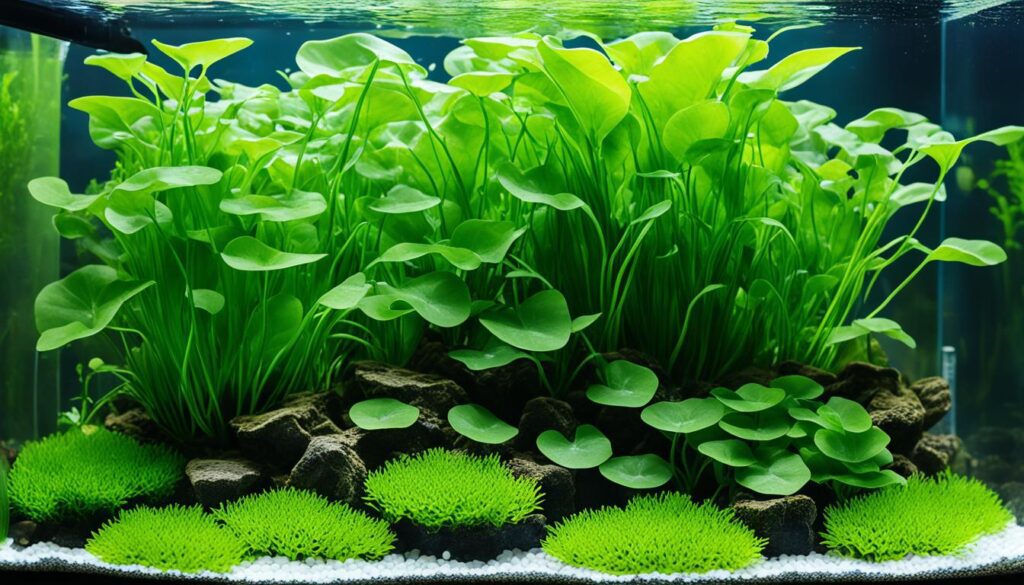
To help Dwarf Water Lettuce grow well in your tank, it’s key to keep the water parameters for Dwarf Water Lettuce just right. Meeting this plant’s needs can make your water garden truly vibrant.
Temperature and Humidity
Dwarf Water Lettuce needs a warm and moist setting, like its tropical home. The best temperature range is between 72°F and 86°F. Don’t let the temperature go below this, or the plant may struggle. High humidity is also important for plants in open tanks. It keeps their leaves from drying out.
pH Levels and Water Hardness
The perfect pH level for floating plants like Dwarf Water Lettuce is 6.5 to 7.5. This keeps the water balanced, letting the plant get nutrients well. The water hardness for aquariums also matters. Ideal conditions are soft to medium hard water, or 4 to 10 dKH. Testing these levels regularly helps keep the plant healthy.
Parameter |
Ideal Range |
|---|---|
Temperature |
72°F – 86°F |
Humidity |
Medium to High |
pH Level |
6.5 – 7.5 |
Water Hardness (dKH) |
4 – 10 |
Keeping these water parameters in check will help your Dwarf Water Lettuce flourish. It will transform your tank into a verdant, floating garden that beautifies and benefits its surroundings.
Lighting Conditions for Dwarf Water Lettuce
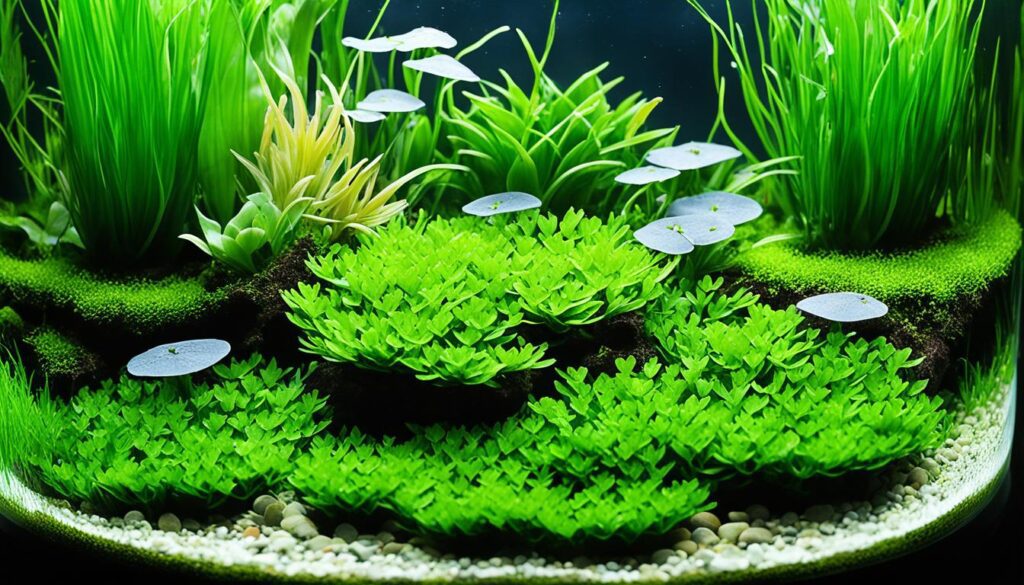
Getting the light right is key for Dwarf Water Lettuce’s health. Many aquarists find this challenging. This floating plant does best in moderate light. It should stay out of direct sunlight to avoid leaf burn. We will explore how light affects Dwarf Water Lettuce photosynthesis and its health.
Understanding Photosynthesis in Floating Plants
Photosynthesis in floating plants like Dwarf Water Lettuce is intriguing. They need light to make the sugars essential for growth. Yet, they can’t handle too much direct sunlight. Instead, they thrive under full-spectrum lights that imitate natural, indirect sunlight. This kind of lighting encourages strong, healthy leaves.
Avoiding Direct Sunlight and Leaf Scorch
Direct sunlight is often a mistake for those new to keeping Dwarf Water Lettuce. To prevent leaf burn, keep sunlight off the plant. Scorching harms its looks and health. It makes leaves weak and disease-prone. Place your aquarium where sunlight is softened, or use curtains to shield the plant. Also, check your aquarium lighting setup often. Adjusting light’s intensity and time can stop problems. This keeps your Dwarf Water Lettuce healthy and vibrant.
Substrate and Floating: The Unique Setup for Dwarf Water Lettuce

Starting a Dwarf Water Lettuce setup offers a special chance. You won’t need a substrate like other plants do. Dwarf Water Lettuce grows with its roots hanging in the water. This makes setting up your tank easier and lets you get creative with your design.
The unique floating plant substrate brings an exciting aspect to your aquarium. Since Dwarf Water Lettuce doesn’t use substrate to grow, you can choose it based only on looks or the needs of other fish. This won’t affect your floating plants.
Not needing a substrate is great for Dwarf Water Lettuce for many reasons:
- Flexibility in Design: Without needing certain substrates, you can make your tank look great or fit other animals’ needs.
- Ease of Maintenance: Tanks with Dwarf Water Lettuce are easier to take care of. You don’t have to check on substrate nutrients or worry about it getting packed down.
- Improved Water Quality: Dwarf Water Lettuce’s roots help clean the water. They take in nitrates that could harm fish or plants. This makes the tank healthier for everyone.
Dwarf Water Lettuce likes it warm, between 72°F and 86°F. It also prefers a pH of 6.0 to 7.5. Keeping them trimmed is key. This stops them from covering the surface and blocking light or air for other plants and animals.
There are many benefits to using Dwarf Water Lettuce in your tank. It’s easy to care for and looks great. This makes it a favorite among people who love aquariums. They want a low-maintenance but beautiful plant.
Planting and Acclimating Dwarf Water Lettuce in Your Aquarium
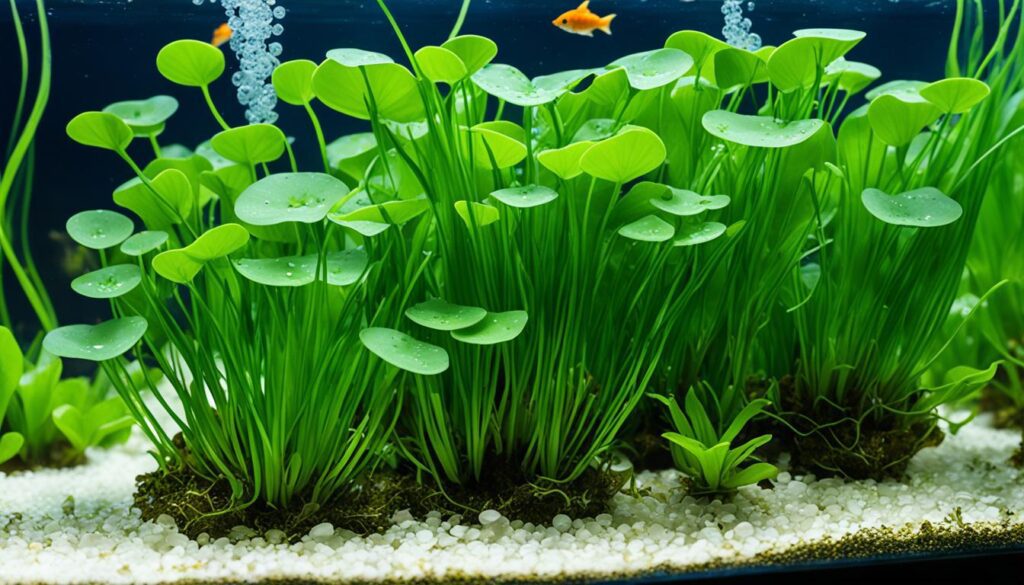
Introducing Dwarf Water Lettuce to your aquarium needs a careful quarantine process. This keeps your plant healthy and your aquarium balanced.
Dwarf Water Lettuce acclimation begins with aligning your quarantine tank’s water to your main aquarium. You should adjust water temperature to 72-86 degrees Fahrenheit. Also, ensure the pH level is between 6.0 and 7.5. Soft to slightly hard water is necessary. Watch carefully for any distress signs in the plant, like root shedding or changing leaf color.
Quarantine Procedures Before Introducing Plants
Setting up a separate area for new Dwarf Water Lettuce is key to the quarantine process. This space allows you to check the plants for pests and diseases. It helps protect your aquarium’s ecosystem. This step usually lasts 1-2 weeks. Doing this ensures your plants are healthy and safe before adding them to your main tank.
Observations Post-Planting
After Dwarf Water Lettuce is in your aquarium, watching its health and growth is crucial. Regular checks of water quality, nutrient levels, and light are needed. You may also need to adjust for water movement to keep the plant’s leaves dry. Since these leaves are water-repellent, they can rot if submerged.
Dwarf Water Lettuce can reproduce quickly in good conditions. So, regular maintenance might be needed to avoid overpopulation. This helps keep your tank’s look and environment in balance.
Dwarf Water Lettuce makes your aquarium look better and helps clean the water. It absorbs unwanted nitrates and phosphates. While its care is simple, it needs regular attention. This ensures the plant does well in its new environment.
Effective Pruning Techniques for Dwarf Water Lettuce
As a passionate aquarist, I’ve learned how crucial pruning Dwarf Water Lettuce is. It’s key for keeping a balanced ecosystem. This plant makes an underwater scene look better but can spread fast. Without regular Dwarf Water Lettuce care, it might take over and disrupt the tank. By pruning carefully, we ensure the plant and aquarium life stay healthy.
Managing Plant Overgrowth
To control this floater, keep an eye on its growth. It’s like managing Salvinia Minima or Duckweed, which grow quickly. By keeping roots about four inches long, we help the plant and the water. This stops too much shade and keeps water flowing well for the tank’s creatures. Keeping 40-60% of the surface covered by floaters requires good pruning skills. It’s as important as feeding fish or checking water quality.
Propagating New Plants Through Trimming
Regular pruning has a bonus: propagation by trimming. It lets us refresh the Dwarf Water Lettuce or start new tanks. Taking young plants from the center prevents overcrowding and promotes new growth. In aquascaping, these practices are crucial for managing tanks. They let us share with friends or add to our collection. Watching the balance between plant growth and space is key to a lively aquarium.
